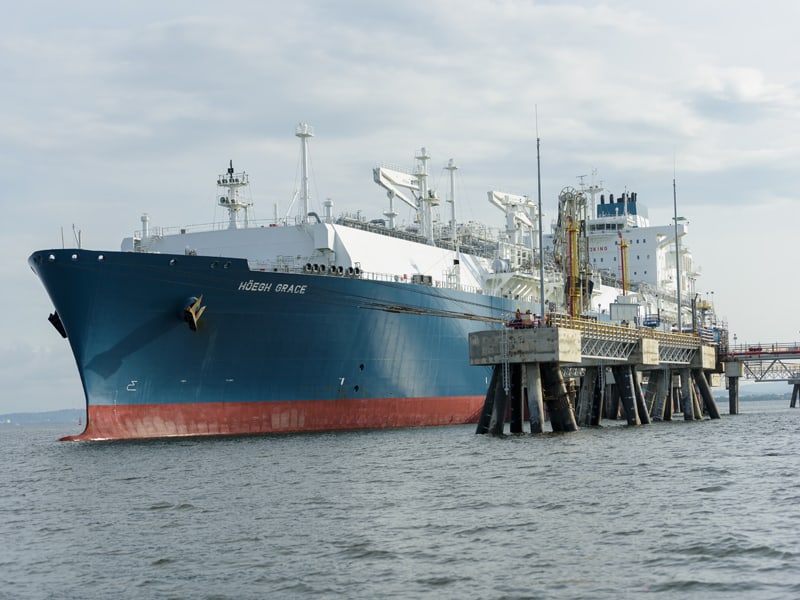Brisbane, Australia-based construction company Watpac has been contracted to provide design, engineering and construction services to EPIK, a South Korean liquefied natural gas (LNG) developer for the onshore* infrastructure components of a floating storage regasification unit (FSRU) at the Port of Newcastle in New South Wales, Australia. Watpac is a subsidiary of Belgian multi-disciplinary engineering company, Besix.
The company has been involved in the design and construction of numerous marine facilities around the world including: the Fortescue tug harbor at Port Hedland, Australia; jetty construction at the South Hook LNG regasification terminal in the U.K., design of the Muharraq Island LNG Import Terminal in Bahrain; and many more.
International marine and engineering consultancy Mott MacDonald has also been engaged as an infrastructure engineering consultant. It has a track record of advising on FSRUs around the world, such as at the 15-million cubic metre facility at Babitonga Bay, Santa Catarina, Brazil.
Seoul-based EPIK announced in early December 2018 that it had entered into an agreement with the Port of Newcastle to build a floating LNG unit called “Newcastle LNG.” If all goes to plan, the FSRU will be located inside the port of Newcastle and will serve the gas market in New South Wales.
The Newcastle LNG facility is forecast to cost between US$400 million and US$430 million and it will include a 170,000-cubic meter FSRU and associated infrastructure. EPIK expects to place an order for the FSRU new-build with a shipyard by early 2020, subject to regulatory approvals.
An FSRU, which can either be purpose-built or converted from an LNG tanker, is used to re-gasify frozen LNG. The “natural gas” in LNG is mostly the chemical compound methane which takes the form of a gas at room temperature. It is cooled to minus 260 Fahrenheit (minus 161 celsius) by being progressively cooled by three refrigerants each with a lower boiling point than the former. These are propane (minus 27.4 F); ethylene (minus 130 F); and methane (-238). The now very-cold methane is then subjected to low pressure which causes it to liquefy and drop in temperature to minus 260 F. At that point, it is LNG that can be carried at atmospheric pressure and remain a liquid.
The liquid state of methane is 1/600th of the volume of the gas state of methane. Cooling and volume reduction of the gas into LNG makes methane economically viable for transport. At the destination harbour, the LNG is loaded into an FSRU first as the liquid cannot be pumped into a gas transmission network straightaway. The FSRU stores the gas and, when needed, it uses seawater to warm up the liquid so that it changes state back into a gas.
EPIK announced back in February that it had concluded an agreement with the Hyundai LNG Shipping Co to develop LNG FSRU projects around the globe, including at Newcastle, Australia. Hyundai LNG operates eight LNG vessels, making it the largest LNG maritime carrier in South Korea. Its eight vessels account for 30 percent of the South Korean-flagged LNG fleet, according to the company. In 2017 it transported approximately 5 million tons of the 36 million tons – just under 14 percent – of South Korea’s domestic LNG imports.
Also involved in the Newcastle LNG project are engineering company Arup, which will provide environmental and planning support, and law firm K&L Gates, which will provide legal and regulatory advice.
EPIK has also stated that it hopes to expand its relationship with the port by later discussing other projects such as a gas-fired power plant and an LNG bunkering facility.
An executive at the Port of Newcastle said that the development is consistent with its diversification strategy. For instance, it’s also trying to develop a container terminal. Newcastle may be overly reliant on coal; the port is one of the world’s biggest coal export ports in terms of throughput volume with 158.6 million metric tons exported in 2018. (A metric ton is equivalent to 2,204.6 U.S. pounds.) Newcastle’s coal throughput was about 99 percent of its export throughput volume in 2018.
But coal exports may not have much of a shelf life anymore. One of the minor – but still important – political parties in Australia, the Greens, is calling for an end to coal exports in the run-up to the likely May 2019 Federal election.
And, as previously reported in FreightWaves, an Australian court has recently refused to allow a coal mine to be developed owing to the effects of coal on climate change.
It’s not the only example of in the world of judicial decisions with an adverse effect on coal-mining. And it’s not just courts either. The U.K. government, for example, is closing coal-fired power stations. Meanwhile, governments in several of Australia’s key export markets, namely China, India, Japan and South Korea have committed to a variety of actions to lower carbon dioxide pollution such as emissions trading schemes, taxes, industry targets, pollution controls and supply restrictions.
* April 05, 2019: following publication of this article, we were contacted by Watpac requesting a clarification to the story in that Watpac is providing design, engineering and construction services for the onshore infrastructure components of EPIK’s Newcastle LNG Floating Storage Regasification Unit (FSRU) import terminal. We are happy to make this clear and apologize for any inconvenience caused.











